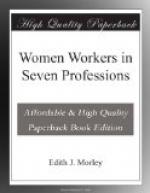There appears to be a tendency to stereotype certain kinds of work for men only, in order to justify the differentiation in pay, but in point of fact, most of the work now exclusively allotted to male telegraphists was at one time done by women. The work done by men and women Counter Clerks is identical. The women in the Telegraph Service have no separate organisation, but combine with the men in the Postal Telegraph Clerks’ Association, which has a large number of branches, and carries on a very active campaign for improvement in pay and conditions of service. Equal pay for equal work is one of the planks in its platform, and formed part of the case put forward before the Select Committee on Post Office Servants last year.
Women Clerks are employed in the great financial Services of the General Post Office, the Savings Bank Department, Money Order Department (including the Postal Order Branch), Accountant-General’s Department, and the Controller’s Office of the London Telephone Service, as well as in the Accountant’s Departments of the General Post Offices in Edinburgh and Dublin. In all, they number nearly 3,000. It may, perhaps, be of interest to go into the history of this class.
Women Clerks were first introduced into the General Post Office in 1871 by Mr Scudamore, who considered that as women were more “fault-finding” than men, they might well be used as “a check on the somewhat illiterate postmasters of the United Kingdom in the interests of a somewhat long-suffering public.” Entry was at first by nomination, but in 1881 the appointment of Women Clerks was thrown open to the public by competitive examination by Mr Fawcett, who was then Postmaster General. This step met with some opposition, and Queen Victoria even caused a letter to be written to Mr Fawcett expressing her strong disapproval of the change. The Postmaster-General, however, carried his point, and fixed the scale of salary at L65, rising by L3 per annum to L80. When the working day was increased from six to seven hours, the maximum was raised to L100. The revisions of the Tweedmouth Inter-Departmental Committee came into force in 1897, involving many concessions to the male staff, and simultaneously the minimum salary of the Women Clerks was, without any warning, reduced for new entrants to L55 per annum, and the increment for the first six years was reduced to L2, 10s.
Realising the defencelessness of their position, the Women Clerks formed an Association in 1901, and so strong was the case for improvement which they were able to bring before the Hobhouse Parliamentary Committee of 1906, that in spite of considerable misrepresentation of their work in the evidence given by Heads of Departments, they were able not only to get back the 1881 minimum of L65, but were awarded further an increased increment of L5 throughout the scale and a rise of L10 in the maximum. This was the position until December 1911, when a tentative scheme was introduced in the




